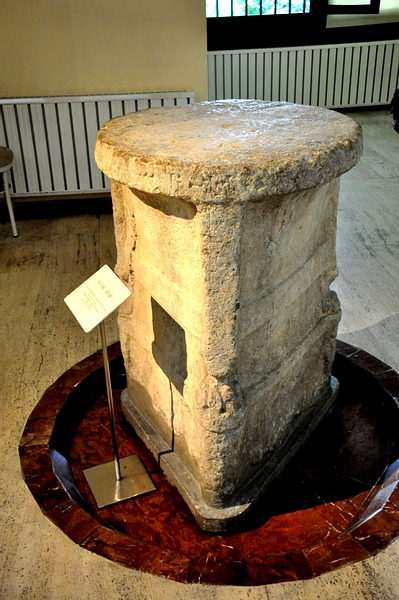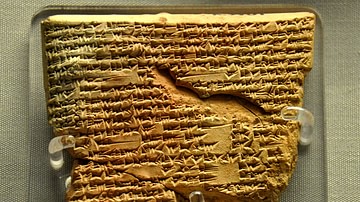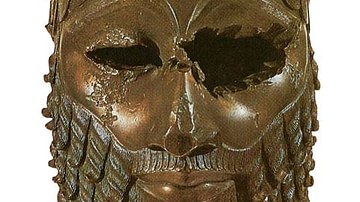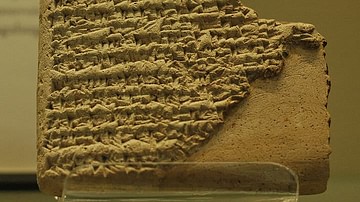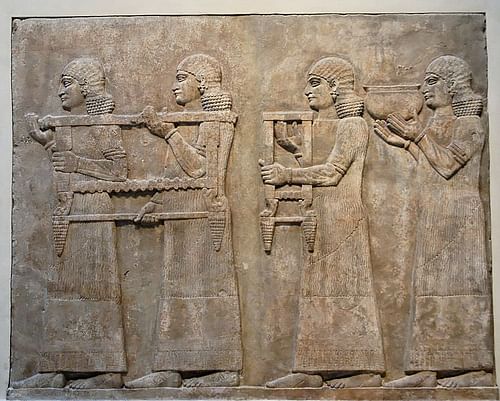
Dur-Sharrukin (modern Khorsabad, Iraq) was a city built by Sargon II of Assyria (r. 722-705 BCE) as his new capital between 717-706 BCE. The name means Fortress of Sargon and the building project became the king's near obsession as soon as it was conceived. He did not live long enough to enjoy it, however, as he died in 705 BCE.
The city covered 1.11 square miles (1.78 km) with a length of 5,770 feet (1,758.6 m) and a width of 5,364 feet (1,635 m) and was surrounded by a wall which was 45 feet (14 m) thick and 39 feet (12 m) high. The city was built, from Sargon's design, to form a near perfect square from which rose a “palace without rival” (as Sargon described it) and a four-story ziggurat. Scholar Stephen Bertman comments on the construction and design:
Sargon's capital city was over a mile square and its design became his preoccupation. The city's dimensions, for example, were based on the numerological value of Sargon's name. Tablets describing the story of the palace's construction were deposited in its cornerstone with the identical text repeated on individual tablets of copper, lead, silver, gold, limestone, magnesite, and lapis lazuli, while paintings illustrated how cedar wood was imported from Lebanon to provide needed timber. Colossal stone bulls with wings and human heads guarded its entranceways. And the walls of the palace were decorated with so much sculpture that the panels, if laid end to end, would stretch for a mile. (19)
Construction began in 717 BCE and would continue for the next ten years. Sargon II was away on campaign during much of this time but kept in touch with his son, the crown prince Sennacherib, regarding the city's progress. He moved in to his new palace in 706 BCE but died on campaign a year later. After his death, the city was abandoned.
The Need for a New Capital
The city of Ashur had been the traditional capital of the Assyrian Empire until the reign of King Ashurnasirpal II (884-859 BCE) who moved the capital to his newly-built city of Kalhu (also known as Nimrud). Ashurnasirpal II decided on this move in order to separate his reign from those of his predecessors but also because the people of Ashur had become more independent owing to the great wealth and prestige of the city.
Ashurnasirpal II felt he could no longer count on the populace to support him and wanted a new city, with a new palace, to assert his authority. Kalhu proved to be just the city he was looking for. It had first been built under the reign of Shalmaneser I (1274-1245 BCE) but had become dilapidated in the years since his reign. Ashurnasirpal II renovated the city, rebuilt the temple, had a new palace constructed, and inaugurated the city as his capital in 879 BCE. Kalhu served the kings of Assyria over the next century but, in 746 BCE, the usurper Tiglath Pileser III (r. 745-727 BCE) overthrew the ruling monarch and took the throne. Regarding this, scholar Karen Radner writes:
That Kalhu's elite could no longer be seen as unquestioningly loyal to whoever happened to be king became very clear in 746 BCE. In that year, a rebellion against king Aššur-nerari V (754-745 BCE) started in Kalhu, in the very centre of the Assyrian state. The revolt was successful and eventually resulted in the ascension of Tiglath-Pileser III to the throne. Having profited from Kalhu's new-found independence from the royal court, he and his chosen heir Shalmaneser V (726-722 BCE) had little reason to fear it. Sargon II, however, faced fierce resistance to his rule after he ousted his brother Shalmaneser in 722 BCE and usurped royal power. Rebellions arose in the western provinces but also, and much more worryingly, in the Assyrian heartland. After he managed to crush the opposition in 720 BCE, he exiled those of his enemies in central Assyria who had survived. Moreover, he immediately took steps to relocate the court and central administration. (1)
Dur-Sharrukin was envisaged as a completely new beginning for Sargon II. He purchased the land from an agricultural community called Magganubba and claimed to have paid the going market price without invoking any kind of royal privilege. Sargon II writes in one inscription:
Magganubba, which lies at the foot of Mount Muṣri and towers above a spring and the surroundings of Nineveh - none of the 350 earlier regents of Assyria realized its favorable location, understood the benefits of its settlement or commanded to dig a canal there. I planned and plotted day and night how to settle this city and to build a sanctuary as the seat of the great gods and palaces as the residence of my rule, and therefore commanded their construction. (Khorsabad cylinder inscription, ll. 44-49)
Once the land had been purchased and construction had begun, Sargon II needed to leave on military campaigns to secure his empire. He continued to oversee his project from afar, however, as is clear from his letters to his son and to those directly involved in building the city.
Construction of the City
Sargon II was no longer interested in ruling from Kalhu and wanted the city built quickly. He was also interested in quality, however, and wanted to make sure it was built well. He canceled the debts of workers in order to procure a steady stream of labor and had his overseers give incentives to skilled workers.
He also, no doubt, used the forced labor of prisoners of war and those civilian populations which had been relocated following conquest (such as the people of Israel and Samaria, whom he conquered early in his reign, c. 720 BCE). His level of personal involvement in the project is made clear through the letters he sent home. Scholar Marc Van De Mieroop writes:
A total of 113 letters can be associated with the building of Dur-Sharrukin, a tenth of all preserved letters from his reign. They involve twenty-six provincial governors, which shows how resources from the entire empire were used. Six letters seem to have been written by the king himself, demanding materials or labor. Three of them are translated here:
1 Letter found in Nineveh
The king's word to the governor of Kalhu: 700 bales of straw and 700 bundles of reed, each bundle more than a donkey can carry, must arrive in Dur-Sharrukin by the first of the month Kislev. Should one day pass by, you will die.
2 Letters found in Kalhu
The 1100 limestones that Bel-lishir-talaktu is loading, let them be brought to me in Dur-Sharrukin quickly! Addressed to the second vizier.
700 limestones that Bel-lishir-talaktu is loading, quickly bring them to me in Dur-Sharrukin! Addressed to the eunuchs. (235)
The city rose steadily through the efforts of a massive labor force even though, at times, there were accidents and delays. One such accident was the loss of two winged bull colossi in the river Tigris. The official overseeing the movement of the statues wrote to the king saying,
To the king, my lord: your servant Assur-bani. Good health to the king, my Lord! Assur-sumi-ke'in called me to help and loaded the bull colossi on the boats, but the boats could not carry the load and sank. Now, although it cost me a great trouble, I have now hauled them up again.
Between 713-710 BCE Sargon II remained, more or less, in Kalhu and regularly oversaw the construction of his city. In 710 BCE he felt he had to finally deal with a problem which had bested him early in his reign. A tribal chief named Merodach-Baladan had taken Babylon and, with Elamite allies, had defeated Sargon II's forces in c. 719 BCE and had then claimed the throne of Babylon and the southern reaches of Mesopotamia. Sargon II again entrusted the building of Dur-Sharrukin to Sennacherib and marched his forces against Elam.
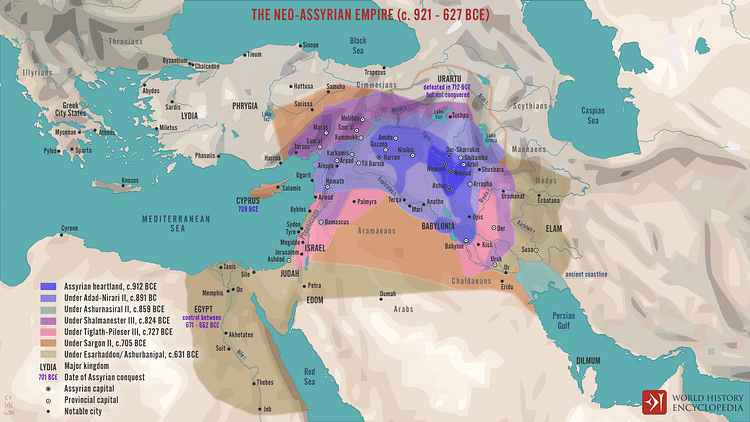
Babylon, Death, & the End of Dur-Sharrukin
Sargon II had been defeated previously by the Elamites and Babylonians because he faced them in a frontal assault on the field. This time he swung his armies to the east and first defeated Elam in order to deprive Babylon of its allies. Merodach-Baladan fled the city and Sargon II entered Babylon, had himself crowned king, and accepted the territories of the south in his role as liberator. He then remained at Babylon for the next three years until word reached him that his city was complete and he could move into his palace.
The city was not actually complete. The walls were done and most of the buildings and, most importantly, the palace, but excavations at the site and ancient letters indicate there was still some significant work to be done. Even so, the city was very impressive. Scholar Gwendolyn Leick writes:
There were seven gates, each dedicated to an Assyrian god. Within a separate enclosure stood the palace and the administrative complex known as the “Palace without Rival”. According to the French excavators, it contained more than 210 rooms, grouped around three courtyards. The portals were guarded by colossal human-headed, winged bulls made of stone, and the walls of the palace were lined with relief-covered limestone slabs that showed the triumph of the Assyrian army and the deeds of Sargon. There were several sanctuaries at Dur-Sharrukin; the most notable was dedicated to the god Nabu and decorated with glazed tiles. (51-52)
Further, there was the great ziggurat of Dur-Sharrukin: a four-story structure with a spiral staircase winding up around it. Each of the levels was painted a different color: white, black, red, and blue. The doors of the palace were bronze, while carved ivory decorated the walls and ceilings. The reliefs that lined the walls depicted Sargon II as a mighty king who destroyed his enemies and built towering monuments. Scholar Susan Wise Bauer comments on this, writing how the reliefs “show his greatness. His huge figure pushes even the forms of the gods into the background” (381). He had wanted a city more beautiful than Kalhu or Ashur, a city no one before him had lived in, and now he had it.
He did not enjoy it for very long. Sargon II moved into his grand palace in 706 BCE and, in 705 BCE, was killed in battle. The Tabal people of Anatolia had risen against the Assyrian Empire and, instead of sending a general to take care of the problem, Sargon II led his army himself. He was killed on the field and the fighting was so fierce that his men could not retrieve his body. This was considered a bad omen by the people of Assyria who concluded that Sargon II must have committed some terrible sin for the gods to have deserted him so completely when he needed them most.
Since Dur-Sharrukin was so closely associated with the king, it was thought to have been tainted by whatever transgression against the gods he had committed and so was abandoned. Sennacherib moved the capital to Nineveh and initiated his own building projects there. Anything which could be moved was taken from Dur-Sharrukin and brought to Nineveh. The city was deserted. While some modern-day scholars claim that Dur-Sharrukin continued on as a provincial capital, others contend that it became effectively a ghost town after the move to Nineveh. The discrepancies in these views come from different interpretations of the modern-day site and the ancient inscriptions.
Collapse & Later Discovery
Dur-Sharrukin eventually collapsed in the fires which took the region after the fall of the Assyrian Empire in 612 BCE. The combined forces of the Persians, Medes, Babylonians, and others swept through the cities of the Assyrians following the death of Sargon II's great-grandson, Ashurbanipal, in 627 BCE and destroyed them. In time, the ruins were buried by the sands and the city was forgotten.
The settlement known as Khorsabad came to be established on the spot, and then, in 1873, the archaeologist Paul Emile Botta began excavations there. These were later carried on by another archaeologist named Victor Place. These men were accompanied, as was standard practice, by artists who would sketch the ruins and the artifacts which were to be moved in situ. Artists like Eugene Flandin and Felix Thomas made careful drawings of every artifact discovered at Dur-Sharrukin, and it was very fortunate that they did.
One boatload of treasures that was being shipped down the Tigris River in 1853 was attacked by Bedouins and sank, while another boatload in 1855 sank under the weight of the artifacts which had been loaded on to it. The second sinking resulted in the loss of two bull colossi, possibly the same two colossi which had sunk the boats in the 8th century BCE. Unlike the workmen under Sargon II, however, no attempts were made in the 19th century to retrieve the treasures from the bottom of the Tigris River and they remain there to the present day. In part due to military conflicts in the region, any plans to raise the sunken treasures in the latter 20th and early 21st centuries have never been implemented.
Those artifacts which did wind up leaving the country may be viewed today in the British Museum, the Louvre, The Oriental Institute of Chicago in the USA and, in country, at the Archaeological Museum in Iraq. Excavations at the site continued into the mid-20th century, with the Oriental Institute of Chicago overseeing the work there from 1928-1935. The Iraqi Department of Antiquities took over the site in the 1950's, and further excavations were conducted under their authority with finds going to the museum in Baghdad. No further work has been carried out at Dur-Sharrukin and, as with the artifacts at the bottom of the Tigris River, this is partly due to armed conflict in the region.

